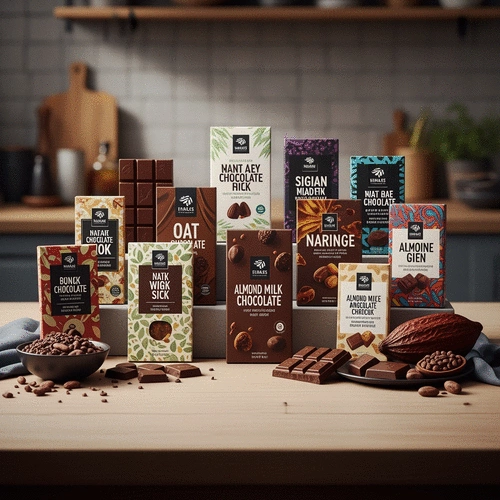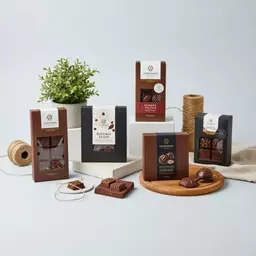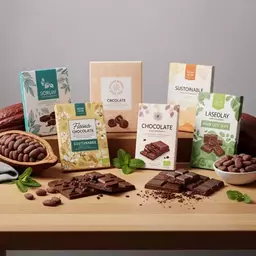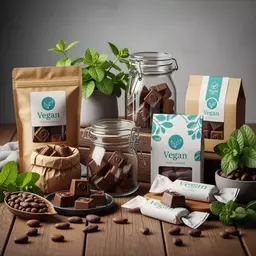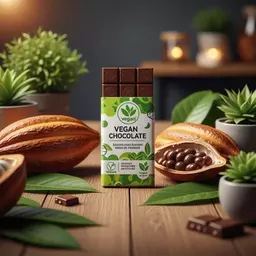Have you ever paused to consider how the ingredients in vegan chocolate transform not just the flavor but the entire experience? This revelation opens the door to a world where indulgence meets ethics, offering a chocolate journey that’s both delightful and responsible.
What You Will Learn
- Vegan chocolate stands out for its commitment to plant-based ingredients that enhance flavor and texture, creating a unique indulgence.
- Milk alternatives, such as oat, almond, and coconut, each contribute distinct flavors and creaminess, elevating the chocolate experience.
- Cacao percentage is key to flavor depth; higher percentages yield richer and more authentic chocolate experiences.
- Sustainable practices in sourcing cacao not only improve the quality of vegan chocolate but also support fair trade and ethical consumption.
Vegan Chocolate: Taste and Texture Insights
Delve into the unique characteristics of vegan chocolate, exploring how different plant-based milks influence its creaminess and flavor, and the importance of cacao percentage. For a deeper dive into making your own, check out our homemade raw vegan chocolate guide.
Plant-Based Ingredients: Core of Vegan Chocolate
- •Sustainable Sourcing: Ethical cacao & fair trade.
- •Diverse Flavors: Unique taste profiles from various milks.
- •Health-Conscious: Often less sugar & healthier fats.
Milk Alternatives & Their Impact
Oat Milk: Creamy texture, subtle sweetness, complements dark chocolate.
Almond Milk: Lighter, nutty, delicate flavor, enhances fruit-infused.
Coconut Milk: Rich, tropical notes, creates a luscious experience.

Understanding Vegan Chocolate: Taste and Texture Insights
Vegan chocolate is not just an alternative; it’s a delightful experience that offers a unique blend of taste and texture. You might be wondering, what makes vegan chocolate so special? Well, it embodies the essence of indulgence while honoring ethical values and sustainability! By using plant-based ingredients, vegan chocolate transforms traditional confectionery into guilt-free treats that everyone can enjoy.
From deep, rich dark chocolates to creamy, luscious varieties, the spectrum of flavors is vast. It invites both seasoned chocolate lovers and newcomers to explore a world filled with delightful surprises. Are you ready to dive deeper into what makes vegan chocolate truly unique?
What Makes Vegan Chocolate Unique?
One of the standout features of vegan chocolate is its commitment to using plant-based ingredients. Unlike conventional chocolate that relies on dairy, vegan chocolate harnesses the power of nature to create delectable treats. The absence of milk opens up a realm of possibilities, allowing flavors to shine through in ways you might never have imagined!
- Sustainable Sourcing: Many brands prioritize ethically sourced cacao, promoting fair trade practices.
- Diverse Flavor Profiles: With various plant-based milks and sweeteners, each chocolate has its own distinctive taste.
- Health-Conscious Options: Vegan chocolates often contain less sugar and healthier fats, making them a better choice for indulgence.
At Vegan Chocolate Guide, we cherish these unique attributes, encouraging you to explore the vast options available. Have you tried a bar that truly reflects these qualities? If not, let's embark on this flavor journey together! For more insights into ethical considerations, read about sustainable cacao in vegan chocolate.
Exploring Plant-Based Milk Alternatives
The choice of milk alternatives plays a crucial role in the flavor and creaminess of vegan chocolate. With so many options available, each brings something special to the table. Let’s take a closer look at three popular plant-based milks and how they influence the chocolate experience!
Oat Milk vs. Almond Milk vs. Coconut Milk
- Oat Milk: Known for its creamy texture, oat milk adds a subtle sweetness that complements dark chocolate beautifully.
- Almond Milk: This option is lighter and nutty, providing a delicate flavor that can enhance fruit-infused chocolates.
- Coconut Milk: With its rich, tropical notes, coconut milk creates a luscious experience, perfect for desserts.
Choosing the right milk can elevate your chocolate experience, making it even more enjoyable! Are you leaning towards a specific one based on what you've tasted?
Impact on Creaminess and Flavor Complexity
The creaminess of vegan chocolate is largely influenced by the type of milk used, impacting the overall flavor complexity. For instance, oat milk offers a smooth mouthfeel, while coconut milk enriching with its tropical richness. By experimenting with different combinations, you can find the right balance that tantalizes your taste buds!
As we explore these options, remember that experimenting is key. Don't hesitate to try various brands and types to discover your personal favorites. What combinations have you enjoyed so far?
Dairy-Free Chocolate: The Heart of Vegan Confectionery
Dairy-free chocolate is the cornerstone of vegan confectionery, making it possible for everyone to indulge without compromise. The transition from traditional chocolate to vegan options opens up delightful possibilities while ensuring ethical production and consumption. As a passionate advocate for sustainable indulgence, I love sharing insights on how to navigate this delicious landscape.
Whether you’re a lifelong chocolate lover or just beginning your plant-based adventure, the world of vegan chocolate has something for everyone. Let’s keep exploring together as we continue our sweet journey into the heart of vegan chocolate!
Pro Tip
When choosing vegan chocolate, look for products with a high cacao content (70% or more) to ensure rich flavor and less sugar. Additionally, consider trying brands that emphasize sustainable sourcing, as this often leads to a more flavorful and ethically produced product. Your taste buds and the planet will thank you!
Recap of Key Points for Choosing Vegan Chocolate
As we’ve journeyed through the decadent world of vegan chocolate, it’s clear that understanding taste, ingredients, and practical applications is essential for making informed choices. Whether you're new to veganism or a seasoned aficionado, knowing what to look for can enhance your chocolate experience dramatically!
Here’s a quick recap of the key points we've discussed:
- Vegan chocolate is unique because it uses plant-based ingredients, allowing for a variety of flavors and textures that can rival traditional chocolate.
- Different milk alternatives like oat, almond, and coconut each bring their own distinct flavor profiles and creaminess to vegan chocolate.
- Understanding cacao percentage is crucial, as higher percentages often mean richer flavors and a more authentic chocolate experience.
- When choosing vegan chocolate, consider ethical sourcing and sustainability to make a positive impact with your indulgences.
This summary serves as a handy guide as you navigate the delightful realm of vegan chocolate. Remember, each choice is a step towards a more sustainable and compassionate lifestyle, and I encourage you to enjoy this process fully!
Frequently Asked Questions About Vegan Chocolate
Here are some common questions about vegan chocolate to help you better understand its unique characteristics and benefits:
What makes vegan chocolate different from regular chocolate?
Vegan chocolate uses plant-based ingredients instead of dairy products, which are typically found in traditional chocolate. This means opting for milk alternatives like oat, almond, or coconut milk, and other plant-derived components, making it suitable for those avoiding animal products.
How do plant-based milk alternatives affect the taste and texture of vegan chocolate?
Each milk alternative contributes distinct characteristics. Oat milk provides a creamy texture and subtle sweetness, almond milk offers a lighter, nutty flavor ideal for fruit-infused chocolates, and coconut milk adds rich, tropical notes, creating a luscious experience.
Why is cacao percentage important in vegan chocolate?
The cacao percentage indicates the amount of cocoa solids in the chocolate. Higher percentages (e.g., 70% or more) generally result in a richer, more intense chocolate flavor and often mean less added sugar, contributing to a more authentic and less sweet experience.
What are the ethical benefits of choosing vegan chocolate?
Choosing vegan chocolate often aligns with ethical values such as supporting animal welfare and promoting sustainability. Many vegan brands prioritize ethically sourced cacao, fair trade practices, and eco-friendly packaging, contributing to a positive environmental and social impact.
Can vegan chocolate be as creamy and satisfying as dairy chocolate?
Absolutely! Advances in plant-based ingredients and crafting techniques have allowed vegan chocolate to achieve exceptional creaminess and rich flavor profiles that can easily rival, and often surpass, traditional dairy chocolate. Experimenting with different brands and milk alternatives can help you find your preferred level of creaminess and indulgence.
Encouraging Exploration of Vegan Chocolate Options
Inviting Readers to Experiment with Different Varieties
Now that you're equipped with the essentials, it's time to embrace the adventure of experimenting with different vegan chocolate varieties! Have you ever tried a chocolate infused with spices or a fruity twist? Exploring new flavors can be a delightful journey that surprises your palate.
Here are a few tasty ideas to get you started:
- Try a dark chocolate with a hint of chili for a spicy kick!
- Go for a coconut milk chocolate if you love tropical flavors.
- For nut lovers, check out nut butter-filled chocolates that offer a creamy texture.
- Don’t shy away from unusual flavor combinations like lavender or sea salt!
Every time you try a new variety, you’ll not only discover more about your taste preferences but also about the artistry behind vegan chocolate!

Connecting Flavor Choices with Ethical Values
Choosing vegan chocolate is also a reflection of our ethical values—a delicious way to support sustainability and animal welfare. By selecting brands that prioritize ethical sourcing, you align your taste preferences with your commitment to compassionate living.
Take a moment to think about what values matter most to you. Are you drawn to brands that support fair trade? Or perhaps you want to explore companies that focus on eco-friendly packaging? Each choice contributes to the larger mission of promoting ethical indulgence. To learn more about how your choices impact the environment, consider reading about vegan chocolate and its environmental impact.
Seasonal Flavors and Their Impact on Vegan Chocolate Choices
Let’s not forget the excitement that seasonal flavors bring to the table! Seasonal ingredients often make their way into chocolate offerings, enhancing the experience and connecting us to different times of the year. Imagine indulging in a spiced pumpkin chocolate in autumn or a refreshing mint chocolate during the holidays!
Here are some seasonal flavor ideas to keep an eye out for:
- Rich hazelnut chocolate in winter
- Light and zesty lemon-infused chocolate in spring
- Summery strawberry swirls or raspberry ganache
Embrace the changes in flavors as they not only elevate your chocolate experience but also create a unique connection to the seasons. I can’t wait to hear about your seasonal finds and how they resonate with your taste buds!
Recap of Key Points
Here is a quick recap of the important points discussed in the article:
- Vegan chocolate is unique because it uses plant-based ingredients, allowing for a variety of flavors and textures that can rival traditional chocolate.
- Different milk alternatives like oat, almond, and coconut each bring their own distinct flavor profiles and creaminess to vegan chocolate.
- Understanding cacao percentage is crucial, as higher percentages often mean richer flavors and a more authentic chocolate experience.
- When choosing vegan chocolate, consider ethical sourcing and sustainability to make a positive impact with your indulgences.

